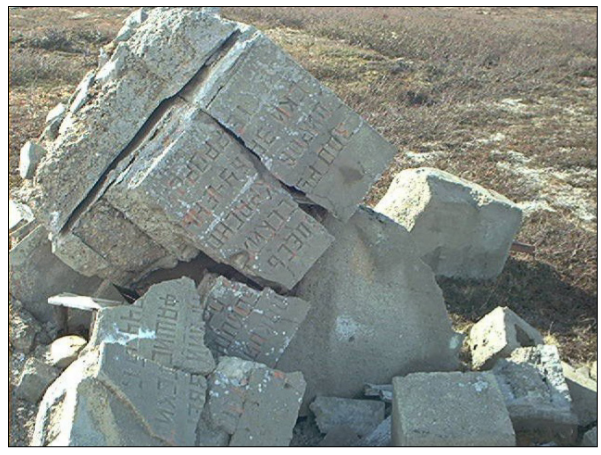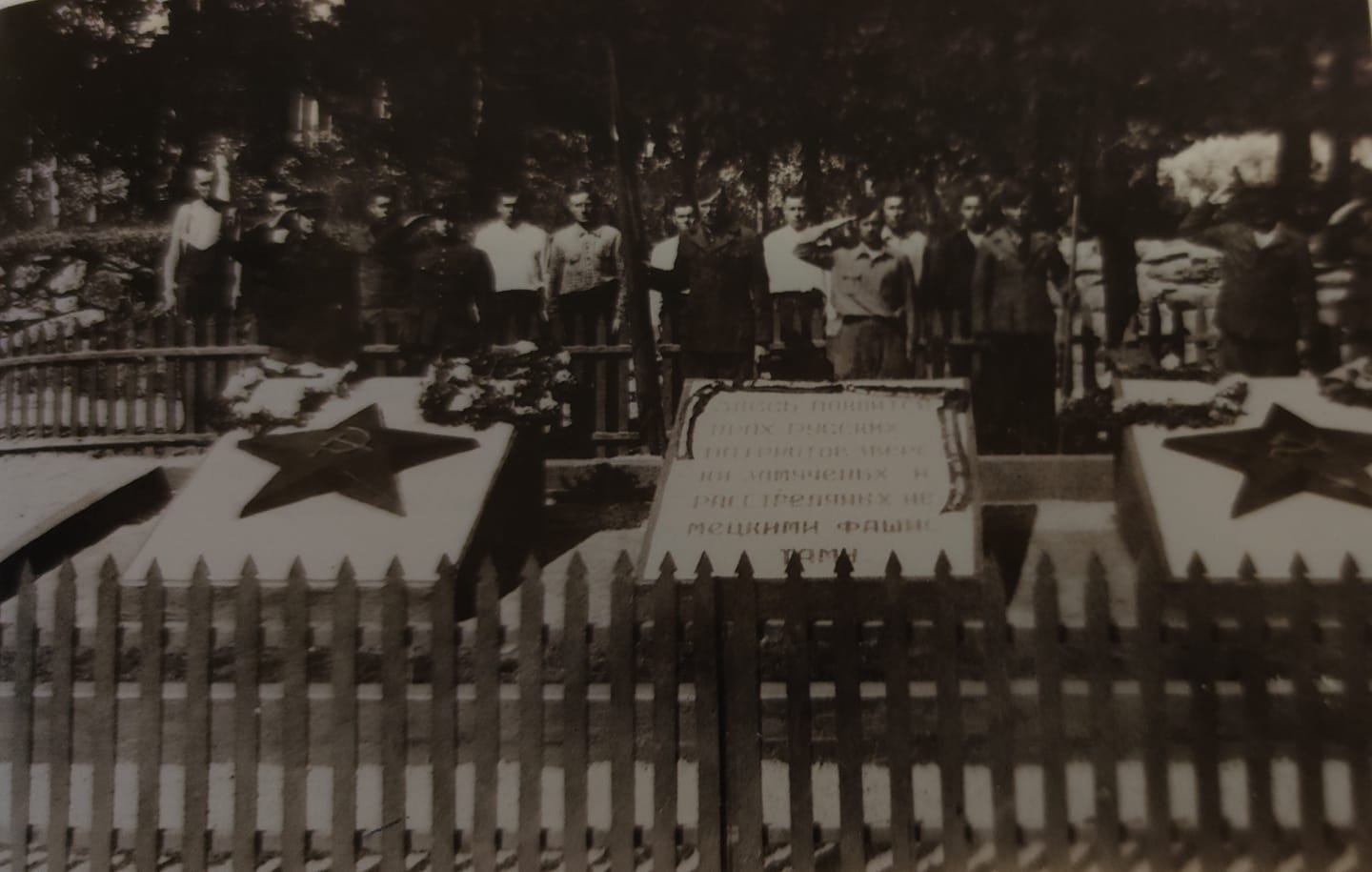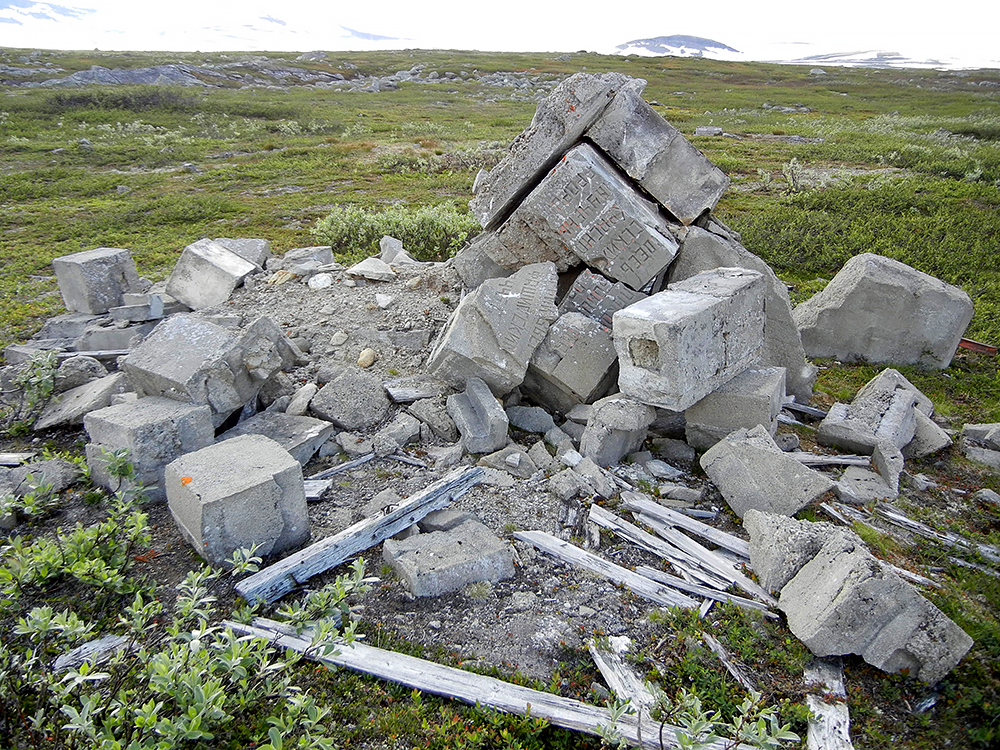“A normally constructed truth lives in the rule
a 17-18 years, maximum 20 years. Rarely anymore. "
- Henrik Ibsen, An Enemy of the People

In the days after the German capitulation on May 8, 1945 and throughout the summer, a large number of memorials were build by the surviving prisoners of war in Nordland, in honor of their deceased brothers.
Many of these monuments were removed during "Operation Asphalt", and although some remained and some new ones were added, this has been seen as part of the erasure of the memory of the Ukrainian prisoners of war, as a politically conscious act. As if that was what it was the intention of the relocation.
In Elvkroken in Sørfold, there was a monument in the war cemetery, which according to the War Grave Service's overview was placed so that it covered several of the buried. It was therefore considered necessary to move it away before the excavation, but along the way it tore apart and collapsed. The monument must have been heavily affected by frost and rain. The same justification is given for having removed the monuments on Helland and Tømmernes in Hamarøy. At Fauske, the monument was set aside in the cemetery, but was intact. The local communists presence may have been a contributing factor to the decision to leave it standing. At Hestbrinken war cemetery in Saltdal, white crosses had been erected on the graves, but no memorial support. In Kobbvatn there was no grave marking, according to the War Grave Service's overviews.
At Bodin Parish Cemetery, three concrete slabs were removed from the burial ground because they were believed to have obstructed the excavation. From the work at Bodø cemetery, the following remark is listed:
"The monument was made of concrete. It was located above the buried. An attempt was made by technical means to lift it so much that the excavation could take place. During the work it tore off each other, and were considered useless to set up again. The monument was heavily covered with frost and wheat. "

On the memorial, which was erected in 1945, was a sickle and hammer emblem, which was taken care of by a private person. Read the history about this memorial.
Blasting of the memorials was a tool that was used in several places, despite the authorities' emphasis on "pious" approach in the work. In the internal instruction that formed the basis for "Operation Asphalt", it was stated that "monuments that had to be raised, and which the work allows to stand, shall be left untouched. " In the war cemeteries, the graves were to be thrown back and put in a reasonable condition after the excavation. In the parish cemeteries one should comply with the requirements of the local cemetery authorities when it came to the restoration of the cemeteries.
The person responsible for the excavation work, Captain Johan Arntzen from the War Graves Service, seems to have given some deviating instructions. That the removal of the memory supports should be one deliberate tactics of those responsible for the operation are refuted by the statements of the Secretary of State in Ministry of Defense in October. As the reactions to the destruction of several monuments increased, Andreas Andersen came with a clear tightening. Now the memorials were going where it was technically possible, remain standing no matter what constitution they were in. That it had to someplaces there was understanding for, but Arntzen's repeated blasting must have been in conflict with the guidelines. This indicates that the captain took liberties in the work and can be attributed actions which was not in line with the central intentions.
That picture is reinforced by the events in October of the year before "Operation Asphalt." Autumn 1950 the original memorial at Storvollen in Rana was blown up. There had been Soviet prisoners of war until the summer of 1945, but they were then moved to the war cemetery on Brennhei. IN Captain Arntzen's report to the War Graves Service dated November 1, 1950, he reasoned the decision that the owner of the area "would break up the land into new land." 255 During the same period, the he blasted the prisoners of war monument at Bjørnelva on Saltfjellet, this time with one another statement:
“These blasting operations were necessary for the sake of the many foreign tourists who travel around every summer and take photos and then report on it
poor maintenance of kkg o.l. in places where it has long since been sorted out. ”
In what appears more like an anecdote than a reliable testimony from the same incident, a construction worker should after asking questions about the cause of the explosion, he was told that “it is so scary for the tourists to see these Ukrainian tombs standing around like this. "Here, Captain Arntzen had anticipated the events and seems to have taken the matter into his own hands hands. His propensity to remove memory pillars was also noticed. «Arntzen's principle regarding stones was that tombstones with inscriptions such as "Here rests" etc. had to be removed », it says in a stamped but unsigned note in the archives of the War Graves Service.
The text of the support at Bjørnelva read «Here are laid to rest 300 Ukrainian soldiers and officers from the Red Army that was tormented by the fascist terror in 1944-45 ». Although the argument for the explosion on Saltfjellet seems somewhat improvised, were still not the claims Arntzen himself came along if the Soviet attention was taken completely out of thin air. In August 1950 it had became known that the Soviet naval attachment was dissatisfied with the war graves in Kirkenes, and believed the war cemetery was poorly maintained. Arntzen himself had been involved in transporting Soviet bodies
the cemetery at Høybuktmoen in Sør-Varanger in 1949.259 The question is which mandate he acted on behalf of when he blew up the memorial at Bjørnelva in 1950, if it was not his own. Where many of the similar choices about removing grave marks during "Operation Asphalt" that were
well-founded, there is also reason to ask. According to the Danish historian Uffe Drost was many of the ruins of the memorials in the fall of 1951 kept hidden from his superiors in ministry.
Halvor Fjermeros also points out Arntzen's wide scope for action as operations manager. Neither before nor after "Operation Asphalt" could there have been the number of memorials that determined the extent to which the emotional and moral ties to the Soviets were maintained prisoners of war. Although many memorial pillars were removed during "Operation Asphalt", it was a long way off from everyone. They are everywhere and have been there all along. In Saltdal there are still a number today original memorials or remnants of them. Lønsdal, Sundby and Stamnes are some of the examples.
One of the texts reads in translation: «Here the dust is buried / by Ukrainian prisoners; perished / Red Guards at the hands of the German / executioner-fascists / Died of starvation - 85 men / shot - 13 men / Sleep dear comrades! / The Fatherland will never forget you. ”
At Mørsy, close to the border between Sørfold and Hamarøy, there is an original memorial with this inscription: «Here the dust rests Ukrainian prisoners of war who fell at the hands of bloody fascism. " At Åsend outside Fauske there is a original memorial, raised by the Soviet prisoners. Despite the hundreds of memorial pillars raised in 1945, the prisoners of war were still not one controversial topic in the years between the end of the war and 1951, when many of them were taken away. Then the prisoners of war disappeared from Norway shortly after the liberation, the attention around them also became
marginalized. The repatriation of prisoners of war must therefore be said to be the first erasure of memory,the physical absence naturally made the attention around them less. Norwegians had enough to rebuild their own lives in the first post-war years. Those who maintained it strongest connection to the prisoners were communists.
As the conflicts of the Cold War became clearer, and especially after Gerhardsen Kråkerøy's speech in 1948 and the outbreak of the Korean War in 1950, these and what they stood for became less attractive to identify with. The great NKP wave disappeared quickly and the Soviet Union became the political enemy. A skepticism grew to stay perceived and branded as Soviet-friendly, at a time when the gufs of the Cold War took over for fear Norwegians had had for the Nazis a few years earlier. It also played into the attention around prisoners of war.

The monument that Ukrainian prisoners of war made in honor of their fallen compatriots was blown to pieces by the Norwegian authorities. It is still located in a mound of ruins on Bjørnelva on Saltfjellet in Nordland, Norway. Photo: Charles Utvik
Source:
HI320S Master's thesis in history
Faculty of Social SciencesGaute Lund Rønnebu 2014

Comments powered by CComment